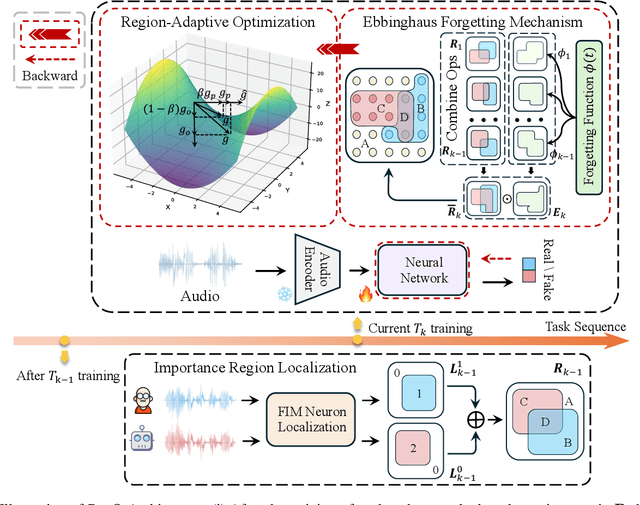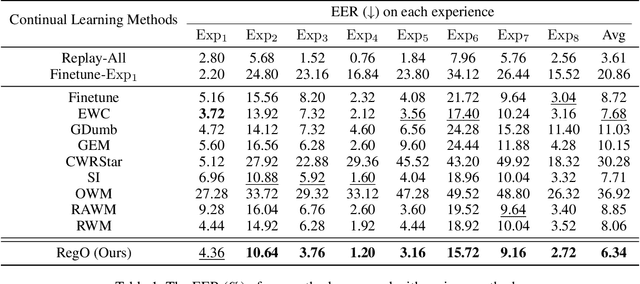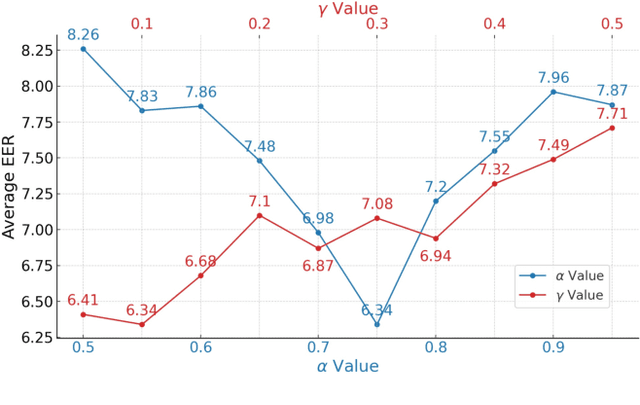Jianhua Tao
RadialRouter: Structured Representation for Efficient and Robust Large Language Models Routing
Jun 04, 2025Abstract:The rapid advancements in large language models (LLMs) have led to the emergence of routing techniques, which aim to efficiently select the optimal LLM from diverse candidates to tackle specific tasks, optimizing performance while reducing costs. Current LLM routing methods are limited in effectiveness due to insufficient exploration of the intrinsic connection between user queries and the characteristics of LLMs. To address this issue, in this paper, we present RadialRouter, a novel framework for LLM routing which employs a lightweight Transformer-based backbone with a radial structure named RadialFormer to articulate the query-LLMs relationship. The optimal LLM selection is performed based on the final states of RadialFormer. The pipeline is further refined by an objective function that combines Kullback-Leibler divergence with the query-query contrastive loss to enhance robustness. Experimental results on RouterBench show that RadialRouter significantly outperforms existing routing methods by 9.2\% and 5.8\% in the Balance and Cost First scenarios, respectively. Additionally, its adaptability toward different performance-cost trade-offs and the dynamic LLM pool demonstrates practical application potential.
ELDeR: Getting Efficient LLMs through Data-Driven Regularized Layer-wise Pruning
May 23, 2025Abstract:The deployment of Large language models (LLMs) in many fields is largely hindered by their high computational and memory costs. Recent studies suggest that LLMs exhibit sparsity, which can be used for pruning. Previous pruning methods typically follow a prune-then-finetune paradigm. Since the pruned parts still contain valuable information, statically removing them without updating the remaining parameters often results in irreversible performance degradation, requiring costly recovery fine-tuning (RFT) to maintain performance. To address this, we propose a novel paradigm: first apply regularization, then prune. Based on this paradigm, we propose ELDeR: Getting Efficient LLMs through Data-Driven Regularized Layer-wise Pruning. We multiply the output of each transformer layer by an initial weight, then we iteratively learn the weights of each transformer layer by using a small amount of data in a simple way. After that, we apply regularization to the difference between the output and input of the layers with smaller weights, forcing the information to be transferred to the remaining layers. Compared with direct pruning, ELDeR reduces the information loss caused by direct parameter removal, thus better preserving the model's language modeling ability. Experimental results show that ELDeR achieves superior performance compared with powerful layer-wise structured pruning methods, while greatly reducing RFT computational costs. Since ELDeR is a layer-wise pruning method, its end-to-end acceleration effect is obvious, making it a promising technique for efficient LLMs.
Thought-Augmented Policy Optimization: Bridging External Guidance and Internal Capabilities
May 21, 2025Abstract:Reinforcement learning (RL) has emerged as an effective method for training reasoning models. However, existing RL approaches typically bias the model's output distribution toward reward-maximizing paths without introducing external knowledge. This limits their exploration capacity and results in a narrower reasoning capability boundary compared to base models. To address this limitation, we propose TAPO (Thought-Augmented Policy Optimization), a novel framework that augments RL by incorporating external high-level guidance ("thought patterns"). By adaptively integrating structured thoughts during training, TAPO effectively balances model-internal exploration and external guidance exploitation. Extensive experiments show that our approach significantly outperforms GRPO by 99% on AIME, 41% on AMC, and 17% on Minerva Math. Notably, these high-level thought patterns, abstracted from only 500 prior samples, generalize effectively across various tasks and models. This highlights TAPO's potential for broader applications across multiple tasks and domains. Our further analysis reveals that introducing external guidance produces powerful reasoning models with superior explainability of inference behavior and enhanced output readability.
$\mathcal{A}LLM4ADD$: Unlocking the Capabilities of Audio Large Language Models for Audio Deepfake Detection
May 16, 2025Abstract:Audio deepfake detection (ADD) has grown increasingly important due to the rise of high-fidelity audio generative models and their potential for misuse. Given that audio large language models (ALLMs) have made significant progress in various audio processing tasks, a heuristic question arises: Can ALLMs be leveraged to solve ADD?. In this paper, we first conduct a comprehensive zero-shot evaluation of ALLMs on ADD, revealing their ineffectiveness in detecting fake audio. To enhance their performance, we propose $\mathcal{A}LLM4ADD$, an ALLM-driven framework for ADD. Specifically, we reformulate ADD task as an audio question answering problem, prompting the model with the question: "Is this audio fake or real?". We then perform supervised fine-tuning to enable the ALLM to assess the authenticity of query audio. Extensive experiments are conducted to demonstrate that our ALLM-based method can achieve superior performance in fake audio detection, particularly in data-scarce scenarios. As a pioneering study, we anticipate that this work will inspire the research community to leverage ALLMs to develop more effective ADD systems.
ImViD: Immersive Volumetric Videos for Enhanced VR Engagement
Mar 18, 2025Abstract:User engagement is greatly enhanced by fully immersive multi-modal experiences that combine visual and auditory stimuli. Consequently, the next frontier in VR/AR technologies lies in immersive volumetric videos with complete scene capture, large 6-DoF interaction space, multi-modal feedback, and high resolution & frame-rate contents. To stimulate the reconstruction of immersive volumetric videos, we introduce ImViD, a multi-view, multi-modal dataset featuring complete space-oriented data capture and various indoor/outdoor scenarios. Our capture rig supports multi-view video-audio capture while on the move, a capability absent in existing datasets, significantly enhancing the completeness, flexibility, and efficiency of data capture. The captured multi-view videos (with synchronized audios) are in 5K resolution at 60FPS, lasting from 1-5 minutes, and include rich foreground-background elements, and complex dynamics. We benchmark existing methods using our dataset and establish a base pipeline for constructing immersive volumetric videos from multi-view audiovisual inputs for 6-DoF multi-modal immersive VR experiences. The benchmark and the reconstruction and interaction results demonstrate the effectiveness of our dataset and baseline method, which we believe will stimulate future research on immersive volumetric video production.
Boosting Multimodal Reasoning with MCTS-Automated Structured Thinking
Feb 04, 2025



Abstract:Multimodal large language models (MLLMs) exhibit impressive capabilities but still face challenges in complex visual reasoning. While recent efforts attempt to enhance MLLMs' reasoning by incorporating OpenAI o1-like structured thinking through explicit search structures or teacher-guided distillation, they often struggle to balance performance and efficiency. A critical limitation is their heavy reliance on extensive data and search spaces, resulting in low-efficiency implicit insight extraction and data utilization. To address this, we propose AStar, an Automated Structured thinking paradigm for multimodal reasoning via Monte Carlo Tree Search (MCTS). AStar automatically derives high-level cognitive reasoning patterns from limited data using MCTS-powered hierarchical structures. Building on these explicit patterns, we design a unified reasoning framework that seamlessly integrates models' internal reasoning capabilities and external reasoning guidelines, enabling efficient inference with minimal tree iterations. This novel paradigm strikes a compelling balance between performance and efficiency. Extensive experiments demonstrate AStar's effectiveness, achieving superior accuracy (54.0$\%$) on the MathVerse benchmark with a 7B backbone, surpassing GPT-4o (50.2$\%$) while maintaining substantial data and computational efficiency.
DReSS: Data-driven Regularized Structured Streamlining for Large Language Models
Jan 29, 2025



Abstract:Large language models (LLMs) have achieved significant progress across various domains, but their increasing scale results in high computational and memory costs. Recent studies have revealed that LLMs exhibit sparsity, providing the potential to reduce model size through pruning techniques. However, existing pruning methods typically follow a prune-then-finetune paradigm. Since the pruned components still contain valuable information, their direct removal often leads to irreversible performance degradation, imposing a substantial computational burden to recover performance during finetuning. In this paper, we propose a novel paradigm that first applies regularization, then prunes, and finally finetunes. Based on this paradigm, we introduce DReSS, a simple and effective Data-driven Regularized Structured Streamlining method for LLMs. By leveraging a small amount of data to regularize the components to be pruned, DReSS explicitly transfers the important information to the remaining parts of the model in advance. Compared to direct pruning, this can reduce the information loss caused by parameter removal, thereby enhancing its language modeling capabilities. Experimental results demonstrate that DReSS significantly outperforms existing pruning methods even under extreme pruning ratios, significantly reducing latency and increasing throughput.
MTPareto: A MultiModal Targeted Pareto Framework for Fake News Detection
Jan 12, 2025Abstract:Multimodal fake news detection is essential for maintaining the authenticity of Internet multimedia information. Significant differences in form and content of multimodal information lead to intensified optimization conflicts, hindering effective model training as well as reducing the effectiveness of existing fusion methods for bimodal. To address this problem, we propose the MTPareto framework to optimize multimodal fusion, using a Targeted Pareto(TPareto) optimization algorithm for fusion-level-specific objective learning with a certain focus. Based on the designed hierarchical fusion network, the algorithm defines three fusion levels with corresponding losses and implements all-modal-oriented Pareto gradient integration for each. This approach accomplishes superior multimodal fusion by utilizing the information obtained from intermediate fusion to provide positive effects to the entire process. Experiment results on FakeSV and FVC datasets show that the proposed framework outperforms baselines and the TPareto optimization algorithm achieves 2.40% and 1.89% accuracy improvement respectively.
BSDB-Net: Band-Split Dual-Branch Network with Selective State Spaces Mechanism for Monaural Speech Enhancement
Dec 26, 2024Abstract:Although the complex spectrum-based speech enhancement(SE) methods have achieved significant performance, coupling amplitude and phase can lead to a compensation effect, where amplitude information is sacrificed to compensate for the phase that is harmful to SE. In addition, to further improve the performance of SE, many modules are stacked onto SE, resulting in increased model complexity that limits the application of SE. To address these problems, we proposed a dual-path network based on compressed frequency using Mamba. First, we extract amplitude and phase information through parallel dual branches. This approach leverages structured complex spectra to implicitly capture phase information and solves the compensation effect by decoupling amplitude and phase, and the network incorporates an interaction module to suppress unnecessary parts and recover missing components from the other branch. Second, to reduce network complexity, the network introduces a band-split strategy to compress the frequency dimension. To further reduce complexity while maintaining good performance, we designed a Mamba-based module that models the time and frequency dimensions under linear complexity. Finally, compared to baselines, our model achieves an average 8.3 times reduction in computational complexity while maintaining superior performance. Furthermore, it achieves a 25 times reduction in complexity compared to transformer-based models.
Region-Based Optimization in Continual Learning for Audio Deepfake Detection
Dec 16, 2024



Abstract:Rapid advancements in speech synthesis and voice conversion bring convenience but also new security risks, creating an urgent need for effective audio deepfake detection. Although current models perform well, their effectiveness diminishes when confronted with the diverse and evolving nature of real-world deepfakes. To address this issue, we propose a continual learning method named Region-Based Optimization (RegO) for audio deepfake detection. Specifically, we use the Fisher information matrix to measure important neuron regions for real and fake audio detection, dividing them into four regions. First, we directly fine-tune the less important regions to quickly adapt to new tasks. Next, we apply gradient optimization in parallel for regions important only to real audio detection, and in orthogonal directions for regions important only to fake audio detection. For regions that are important to both, we use sample proportion-based adaptive gradient optimization. This region-adaptive optimization ensures an appropriate trade-off between memory stability and learning plasticity. Additionally, to address the increase of redundant neurons from old tasks, we further introduce the Ebbinghaus forgetting mechanism to release them, thereby promoting the capability of the model to learn more generalized discriminative features. Experimental results show our method achieves a 21.3% improvement in EER over the state-of-the-art continual learning approach RWM for audio deepfake detection. Moreover, the effectiveness of RegO extends beyond the audio deepfake detection domain, showing potential significance in other tasks, such as image recognition. The code is available at https://github.com/cyjie429/RegO
 Add to Chrome
Add to Chrome Add to Firefox
Add to Firefox Add to Edge
Add to Edge